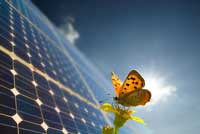
Solar radiation warms our biosphere, grows our trees and crops, and creates our weather. We can harness it directly to heat and cool our homes (passive solar), heat our water, cook our food (solar cookers), or to make electricity from photovoltaic (PV) panels. The most efficient and direct use of solar radiation is to heat water. 3% of all US energy consumption is for hot water heating. The average 4-person family in the USA consumes about 60-80 gallons of hot water each day. If you live in a house with good southern exposure, abundant sunshine, and want to heat your water (at least partially) with the sun, this is a great investment.
Solar heating is the most efficient and effective of all our solar technologies. While solar PV arrays hover around 10-16% efficiencies, solar water heating can get over 60% efficient depending on your system design. There are thousands of solar hot water systems in use since the early 1900’s. Paint anything black, put it in the sun and it gets hot. Even campers enjoy hot showers when the sun is shining by hanging a simple black plastic water container in the sun. For domestic usage, you’ll need to install some type of hot water tank storage and supplemental water heating for nighttime usage and cloudy days. Energy savings from solar water heating are remarkable. Heating water with the sun can be simple or complex, there are many system choices.
Like any technical system, solar hot water requires some precautions: Hard Water: If you use city or ground water, chances are you have hard water – calcium and magnesium. To keep your solar hot water system from clogging up due to corrosion, you must install a water conditioner or other anti-scaling equipment. Freezing: If there is even a remote possibility of freezing temperatures in your area, you need to protect your solar hot water system from freezing. There are several ways to prevent freezing water by draining back the collector at the end of the day, or by using an active indirect, anti-freeze type system. Scalding: An issue with any hot water system is scalding. Most modern homes have tempering valves that prevent this. It’s doubly important on solar hot water systems to have tempering valves properly installed and set to prevent scalding. In some systems the tempering valves are set at 80F max; to prevent auxiliary heaters from overheating the solar hot water. Adjustment: As with any solar system, if
it is not properly designed it can waste tremendous amounts of energy
without the homeowner’s awareness. Example: having one wrong
set-point within an active circulating solar hot water system can
waste 100’s of gallons of ‘free’ hot water each
day. The more complex your system, the more importance of maintaining
proper set points.
The differences between these systems are complexity, cost, maintenance and efficiencies. Choosing between these 3 systems depends on your own … • …# annual hours below or near
freezing 1. Passive systems usually consist of a breadbox style design. A black water tank is placed inside a sealed box with a window on it facing the sun. This allows water in your tank to be directly heated by the sun. It is by far the cheapest of all solar hot water systems, but also very inefficient since it takes an inordinate amount of time to heat all that water in the tank. If you live in a sunny climate, and have a ready S-SW window area available to relocate your existing hot water heater to – this would be an excellent option for you. Most people do not have this available. Freezing is usually not a problem with these breadbox systems because the tanks are located indoors and their sheer size makes them resistant to overnight freezing. However the pipes leading to and from the system must have freeze protection. 2. Thermo-siphon systems take advantage of hot water’s tendency to flow upward (actually cold water descends, but who’s counting?) by placing a solar water collector below a water storage tank. This requires having the proper collector orientation and a structurally sound place to store a heavy water tank above (more than 18 inches) the collector. Remember that water weighs around 8 pounds per gallon – so a 40 gallon water tank will weight 320 pounds – not something to take ‘lightly’. Freezing is usually not a problem with thermo-siphon systems because there is an automatic drain-back after the sun sets preventing overnight freezing. However the pipes leading to and from the system must have some type of freeze protection. 3. Active systems are the most complex systems and require engineered designs, substantial investment and maintenance. Active systems are specifically designed to be used in very cold climates to prevent water freezing. The pipes leading to and from these active systems also need freeze protection. Active systems are usually installed by people that are technically savvy homeowners, or they will contract someone to do regular checks and maintenance. Without vigilant maintenance, these systems may present problems most homeowners are not ready to tackle. One common problem with active pumped solar hot water systems is that due to their complexity (controls, valves, pumps); if one component fails in the system the entire system can fail, can freeze, and can crack pipes and system components. The three active water heating systems are drain-down, drain-back, and closed-loop antifreeze. A drain-down system pumps city water under pressure through the solar collectors (there must be adequate psi for the height of your collectors). A drain-back system pumps water from a small tank through the collectors and a heat exchanger. A closed-loop, antifreeze system pumps a non-freezing fluid (anti-freeze, glycol, etc.) through the collectors to a heat exchanger. Drain-down and drain-back systems rely on solenoid valves or pump controls for freeze protection. Equipment malfunctions can be expensive, as they can lead to freezing and cracked pipes and components.
Figure 1: Active Solar Hot Water system with Glycol loop Another common feature of an active solar hot water system is to use a photovoltaic powered water pump without battery storage capability (Figure 1 system has one) to pump water only when the sun is shining. Lessons learned from numerous Federal DOE active solar hot water systems projects are:
The economics of solar active hot water systems are not as cost effective in most northern climates in the USA as passive and thermo-siphon systems. Tank-less hot water systems may be a better first option in these areas  |



 The
main difference between most direct systems is the location of temperature
controllers and heat exchangers. They can be either inside the hot water
storage tank or outside the tank. Figure 1 shows a simplified version
of such an active system.
The
main difference between most direct systems is the location of temperature
controllers and heat exchangers. They can be either inside the hot water
storage tank or outside the tank. Figure 1 shows a simplified version
of such an active system.







